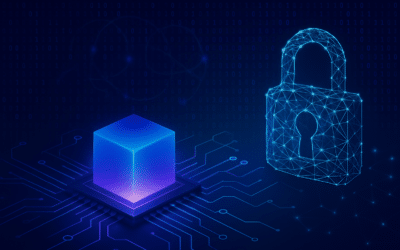Quantum...
Gathering and Analyzing Cyber Threat Intelligence
Cyber Threat Intelligence: Safeguarding the Digital Realm
In today’s digital age, cyber threats are becoming increasingly sophisticated, making it essential for organizations to adopt robust threat intelligence strategies. Cyber threat intelligence (CTI) involves gathering, analyzing, and utilizing information about potential and existing threats to enhance an organization’s security posture. This blog will explore the key aspects of cyber threat intelligence, including gathering and analyzing threat intelligence, using it to predict and prevent attacks, and building a comprehensive threat intelligence program.
1. Gathering and Analyzing Threat Intelligence
The first step in any effective threat intelligence program is the collection and analysis of relevant data. This involves:
Data Collection: Gathering information from various sources, including open-source intelligence (OSINT), dark web monitoring, and threat intelligence feeds. This data can include indicators of compromise (IOCs), threat actor profiles, and attack patterns.
Data Processing: Normalizing and structuring the raw data to make it manageable and actionable. This step often involves the use of automated tools to filter out irrelevant information and highlight significant threats.
Analysis: Examining the processed data to identify patterns, trends, and potential threats. This analysis helps in understanding the tactics, techniques, and procedures (TTPs) used by threat actors.
By effectively gathering and analyzing threat intelligence, organizations can gain valuable insights into the threat landscape and make informed decisions to protect their digital assets. This process is crucial for those in information technology management jobs as it helps them stay ahead of potential threats and ensure the security of their systems.
2. Using Threat Intelligence to Predict and Prevent Attacks
Once threat intelligence is gathered and analyzed, it can be used to predict and prevent cyber attacks. Here are some ways to leverage threat intelligence:
Early Detection: Integrating threat intelligence with existing security solutions, such as Security Information and Event Management (SIEM) systems, to detect suspicious activities early. This allows security teams to respond quickly and mitigate potential threats before they escalate.
Proactive Defense: Using threat intelligence to identify vulnerabilities and implement preventive measures. For example, updating software patches, setting access controls, and restricting permissions based on the latest threat data.
Incident Response: Enhancing incident response capabilities by providing context and actionable insights. Understanding the attacker’s motives and methods helps in anticipating their next moves and minimizing damage.
By using threat intelligence proactively, organizations can stay one step ahead of cyber adversaries and strengthen their overall security posture. This is particularly important in the context of information technology vs cybersecurity, where the focus is not only on managing information but also on protecting it from threats.
3. Building a Threat Intelligence Program
Building a comprehensive threat intelligence program involves several key steps:
Define Objectives and Scope: Clearly define the goals of the threat intelligence program and identify the specific threats and vulnerabilities it will address. This includes understanding the organization’s critical assets and the types of adversaries that may target them.
Develop a Collection and Analysis Plan: Establish a plan for collecting and analyzing threat intelligence. This includes identifying sources of data, setting up automated collection processes, and defining analysis methodologies.
Integrate with Security Operations: Ensure that the threat intelligence program is integrated with other security operations, such as incident response, vulnerability management, and red teaming. This integration helps in creating a holistic view of the organization’s security landscape.
Train and Educate: Provide training and education to threat intelligence analysts and other relevant stakeholders. This includes hands-on workshops, training on using threat intelligence tools, and creating documentation such as standard operating procedures and reporting templates.
Continuous Improvement: Regularly review and update the threat intelligence program to keep it effective. This involves measuring performance against objectives, identifying areas for improvement, and staying updated with the latest threat trends.
By following these steps, organizations can build a robust threat intelligence program that enhances their ability to detect, prevent, and respond to cyber threats. This is essential for vice president information technology jobs, where strategic oversight and decision-making are critical.
The Role of Artificial Intelligence in Threat Intelligence
Artificial intelligence (AI) is playing an increasingly important role in threat intelligence. AI can analyze vast amounts of data quickly and accurately, identifying patterns and predicting potential threats. This capability is transforming how organizations approach cybersecurity, making it more proactive and efficient.
For instance, AI can help in identifying zero-day vulnerabilities and advanced persistent threats (APTs) by analyzing behavioral patterns and anomalies in network traffic. This is particularly beneficial in the healthcare sector, where AI can enhance security measures and protect sensitive patient data. The benefits of artificial intelligence in healthcare include improved diagnosis accuracy, personalized treatment plans, and enhanced patient care.
Moreover, AI can automate many aspects of threat intelligence, from data collection to analysis and response. This not only improves efficiency but also reduces the likelihood of human error. For those new to the field, understanding cybersecurity for beginners is crucial, and AI can provide a significant advantage by simplifying complex processes and providing actionable insights.

Interested in becoming a student?
Look for your passion in our available programs
Best Practices for Integrating Threat Intelligence Tools
Integrating threat intelligence tools into an organization’s security strategy involves several best practices:
Adopt a Proactive Approach to Intelligence: Use threat intelligence to guide security policies, allowing teams to identify vulnerabilities before attacks occur. This includes restricting access permissions, setting access controls, and identifying necessary updates and patches.
Combine Threat Intelligence with Existing Security Solutions: Threat intelligence solutions are most effective when integrated with other security tools, such as SIEM systems. This provides a centralized platform for monitoring and collecting security data, offering early warnings with context for alerts.
Automate Where Possible: Automation can drive efficiency, productivity, and error reduction. However, it is essential to ensure that the organization has the staff to develop, maintain, and support the automation tools. Automation should be implemented when the organization is at an advanced maturity level and can closely monitor and optimize the processes.
The Importance of Information Sharing
Information sharing is a critical component of effective threat intelligence. Organizations must share information about threats with one another to better understand the broader cyber threat landscape. This can be done through various channels, including government agencies, private sector organizations, and open-source information platforms.
Sharing information helps organizations stay ahead of potential threats by providing them with advance warning of potential attacks. This allows them to take proactive measures to protect themselves, rather than simply reacting to attacks after they have occurred. This collaborative approach is essential for information technology and people, as it fosters a culture of security awareness and collective defense.
Emerging Trends in Cyber Threat Intelligence
As cyber threats continue to evolve, so do the methods and tools used in threat intelligence. One notable trend is the increasing reliance on machine learning and AI to enhance threat detection and response capabilities. These technologies enable the analysis of large datasets to identify anomalies and predict future threats more accurately.
Another trend is the growing importance of threat intelligence sharing across industries and sectors. Collaborative platforms and partnerships are being established to facilitate the exchange of threat information, which helps organizations improve their defenses collectively. This approach is particularly beneficial for small and medium-sized enterprises (SMEs) that may lack the resources for extensive threat intelligence programs on their own.
Additionally, the integration of threat intelligence with broader risk management strategies is becoming more prevalent. Organizations are recognizing that understanding and mitigating cyber threats is not just an IT issue but a critical component of overall business risk management. This integration ensures that cyber risks are considered alongside other business risks, leading to more comprehensive and effective risk management practices.
Case Study: Successful Implementation of a Threat Intelligence Program
To illustrate the benefits of a comprehensive threat intelligence program, consider the case of a global financial institution that implemented such a program to protect its digital assets. The institution faced frequent and sophisticated cyber threats, including phishing attacks, malware, and advanced persistent threats (APTs).
By adopting a robust threat intelligence strategy, the institution was able to enhance its threat detection and response capabilities significantly. The program included the following elements:
– Advanced Data Collection: Utilizing a wide range of data sources, including OSINT, dark web monitoring, and proprietary threat intelligence feeds.
– Automated Analysis*: Implementing AI and machine learning tools to analyze data and identify patterns indicative of potential threats.
– Proactive Defense Measures: Regularly updating security protocols and implementing preventive measures based on the latest threat intelligence.
– Integrated Security Operations: Ensuring seamless coordination between the threat intelligence team and other security functions, such as incident response and vulnerability management.
– Continuous Improvement: Regularly reviewing and refining the threat intelligence program to adapt to evolving threats and incorporate new technologies.
As a result, the financial institution saw a significant reduction in successful cyber attacks and was able to respond more quickly and effectively to potential threats. The program also improved the institution’s overall security posture and enhanced its ability to protect sensitive customer information.
Conclusion
Cyber threat intelligence is an essential aspect of modern cybersecurity. By gathering, analyzing, and utilizing threat intelligence, organizations can enhance their security posture and protect their digital assets from sophisticated cyber threats. Building a comprehensive threat intelligence program involves defining objectives, developing a collection and analysis plan, integrating with security operations, training and educating stakeholders, and continuously improving the program.
The integration of AI in threat intelligence is revolutionizing the field, providing organizations with the tools they need to stay ahead of emerging threats. By adopting best practices and fostering information sharing, organizations can build a robust threat intelligence program that enhances their ability to detect, prevent, and respond to cyber threats.
Incorporating these strategies and leveraging the power of AI can significantly improve an organization’s cybersecurity efforts, making it more resilient against the ever-evolving threat landscape. This is particularly important for those in information technology management jobs and vice president information technology jobs, where strategic oversight and decision-making are critical to ensuring the security and integrity of the organization’s digital assets.
By understanding the principles of information technology and the differences between information technology vs cybersecurity, organizations can develop a comprehensive approach to threat intelligence that addresses both the management and protection of information. This holistic approach is essential for building a secure and resilient digital environment in today’s interconnected world.
Become a student at Atlantis University
Related Posts
Digital Transformation Certificate for Future Leaders 2025
Explore our...
Sports Media Career: 10 Powerful Reasons to Get Started Today
Discover 10...
Human Intelligence Augmented by Artificial Intelligence – The Only Viable Path for Humanity in 2025
Human...
What’s Driving the Powerful Bahamas Tourism Industry in 2025
Explore how...
10 Powerful Reasons Norwegian Cruise Line Careers Offer Exceptional
Norwegian...










